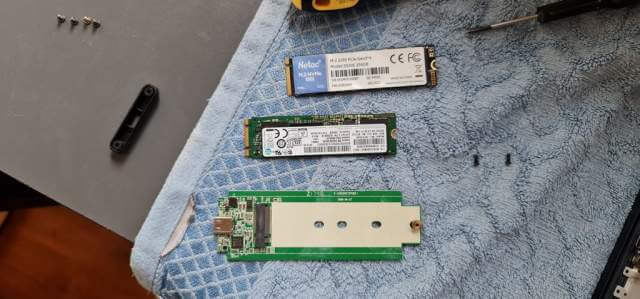Last week, a customer brought a four-year-old Sony Vaio VJFE54F11UAR model laptop to me that wouldn’t boot to Windows and instead went directly to the BIOS. Upon further investigation, it was found that no NVMe drive was installed. I then booted from a WinPE rescue pen drive, and no disk was present, so I opened up the laptop.
 I was surprised to find a brand of NVMe I had never seen before, so I removed the 256GB Netac NVMe, put it into a USB enclosure, then a PCIe adaptor, but it didn’t show up in my test rig. This is the first time I’ve come across a dead NVMe – a soldered EMMC, yes. It was particularly annoying because the client had important files on it that hadn’t been backed up, and the laptop is only four years old. She later told me that she did at least have some files backed up to a pen drive.
I was surprised to find a brand of NVMe I had never seen before, so I removed the 256GB Netac NVMe, put it into a USB enclosure, then a PCIe adaptor, but it didn’t show up in my test rig. This is the first time I’ve come across a dead NVMe – a soldered EMMC, yes. It was particularly annoying because the client had important files on it that hadn’t been backed up, and the laptop is only four years old. She later told me that she did at least have some files backed up to a pen drive.
I Need My Laptop ASAP!
I don’t like being rushed when repairing computers, and being told that the client had an important video conference the following morning at 08:30 did put pressure on me. I could either get it fixed for later that day or hand it over to her at 07:30 the following morning, when I’m usually a little bleary-eyed. I explained that she would need a new NVMe, and for good measure, she should consider an extra stick of DDR4 RAM to bring her up to 16GB total, to which she agreed.


I had already sourced the 500GB Hiksemi NVMe and memory, so I jumped on my bike and bought them. However, the lad in the shop was not my usual contact, and when I returned to the workshop, I found that he had given me a SATA M.2 drive, which is not compatible with PCIe. I then zoomed back to the shop, where he insisted that it was indeed NVMe in spite of my pointing out the difference. Long story short, his boss arrived and they covered their mistake by exchanging the erroneous drive with a superior Hiksemi Future Lite NVMe at no extra cost.


Fixed And Delivered In Record Time
With a fast drive and plenty of memory, Windows 11 was installed in under ten minutes, and using Rufus, I was able to bypass the online sign-in requirement, install the drivers, and have it ready for the customer by the time the pubs opened later that day. She was more than happy with the result, saying that it flies along, and I was glad of the happy ending. However, I was surprised to see Sony fitting a relatively unknown brand of NVMe, and can only assume that it was a cost-cutting measure. As for NVMe drives failing, it’s a first for me, but not for others, because this was not an isolated incident.
My advice is, back up just to be sure!
—
